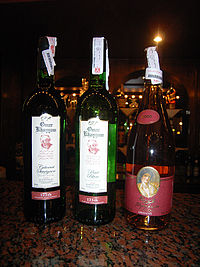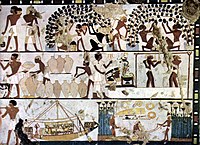
There is a long history of alcoholic drinks in China. They include rice and grape wine, beer, whisky and various liquors including baijiu, the most-consumed distilled spirit in the world.

Tannat is a red wine grape, historically grown in South West France in the Madiran AOC, and is now one of the most prominent grapes in Uruguay, where it is considered the "national grape".

California wine has a long and continuing history, and in the late twentieth century became recognized as producing some of the world's finest wine. While wine is made in all fifty U.S. states, up to 90% of American wine is produced in the state. California would be the fourth largest producer of wine in the world if it were an independent nation.

Israeli wine is produced by hundreds of wineries, ranging in size from small boutique enterprises to large companies producing over ten million bottles per year.

Spanish wine includes red, white, and sparkling wines produced throughout the country. Located on the Iberian Peninsula, Spain has over 1.2 million hectares planted in wine grapes, making it the most widely planted wine-producing nation, but the second largest producer of wine in the world, behind Italy and ahead of France and the United States. This is due, in part, to the very low yields and wide spacing of the old vines planted on the dry soils found in some of the Spanish wine regions. The country is ninth in worldwide consumption with Spaniards drinking, on average, 21.6 litres per person a year. The country has an abundance of native grape varieties, with over 400 varieties planted throughout Spain, though 88 percent of the country's wine production is from only 20 grapes — including the reds Tempranillo, Bobal, Garnacha, and Monastrell; the whites Albariño, Airén, Verdejo, Palomino, and Macabeo; and the three Cava grapes Parellada, Xarel·lo, and Macabeo.
The glossary of wine terms lists the definitions of many general terms used within the wine industry. For terms specific to viticulture, winemaking, grape varieties, and wine tasting, see the topic specific list in the "See also" section below.

The following outline is provided as an overview of and topical guide to wine:

The oldest fossil proto-wines without grapes were found in China, in 7000 BC, and evidence of ancient wine production has been found in Georgia from c. 6000 BC , Iran from c. 5000 BC, Greece from c. 4500 BC, Armenia from c. 4100 BC, and Sicily from c. 4000 BC. The earliest evidence of a grape and rice mixed based fermented drink sometimes compared to wine was found in ancient China.

Egyptian cuisine makes heavy use of poultry, legumes, vegetables and fruit from Egypt's rich Nile Valley and Delta. Examples of Egyptian dishes include rice-stuffed vegetables and grape leaves, hummus, falafel, shawarma, kebab and kofta. ful medames, mashed fava beans; koshary, lentils and pasta; and molokhiya, bush okra stew. A local type of pita bread known as eish baladi is a staple of Egyptian cuisine, and cheesemaking in Egypt dates back to the First Dynasty of Egypt, with Domiati being the most popular type of cheese consumed today.

Straw wine, or raisin wine, is a wine made from grapes that have been dried off the vine to concentrate their juice. Under the classic method, after a careful hand harvest, selected bunches of ripe grapes will be laid out on mats in full sun.. This drying will probably be done on well exposed terraces somewhere near the wine press and the drying process will take around a week or longer. Small scale productions were laid out on flat roofs; however, if this still happens, it is extremely rare nowadays.

The Cypriot wine industry ranks 50th in the world in terms of total production quantity, and much higher on a per-capita basis. The wine industry is a significant contributor to the Cypriot economy through cultivation, production, employment, export and tourism.

Wine has a long history in China. Although long overshadowed by huangjiu and the much stronger distilled spirit baijiu, wine consumption has grown dramatically since the economic reforms of the 1980s. China is now numbered among the top ten global markets for wine. Ties with French producers are especially strong, and Ningxia wines have received international recognition.

Catalan wines are those that are produced in the wine regions of Catalonia. Occasionally, the appellation is applied to some French wine made in the Catalan region of Roussillon and neighboring areas, also known as Northern Catalonia or the Pays catalans. The city of Barcelona is the capital of Catalonia and despite not being in a wine region, it is the focal point of the Catalan wine industry: a primary consumer market, its port provides export functions and a source of financial resources and investment. The Penedès is the largest wine-making region in Catalonia.

Wyoming wine refers to wine made from grapes grown in the U.S. state of Wyoming. There are no designated American Viticultural Areas in Wyoming. The state has two commercial wineries, Table Mountain Vineyards in Huntley and Wyoming Wine in Sheridan. Table Mountain Vineyards is Wyoming's largest with a 10-acre (40,000 m2) vineyard and produced 3,000 gallons in 2007 from 100% Wyoming grapes. The winery helped pave the way for the Wyoming Grape and Wine Association (WGWA) which focuses on expanding and developing the Wyoming grape industry. Table Mountain Vineyards has paired up with several wineries in western Nebraska to promote wineries along the historic emigration trails, including the Oregon Trail.

The modern Indian Wine market is small but growing; annual per capita consumption of wine in the country is a mere 9 milliliters, approximately 1/8000th that of France. The main reason for this can be attributed to the fact that Indians preference for hard liquor and beer boasts nearly 98% of market share whereas wine with low ABV only has 2% market share. The viticulture in India has a long history dating back to the time of the Indus Valley civilization when grapevines were believed to have been introduced from Persia. Winemaking has existed throughout most of India's history but was particularly encouraged during the time of the Portuguese and British colonization of the subcontinent. The end of the 19th century saw the phylloxera louse take its toll on the Indian wine industry followed by religious and public opinion moving towards the prohibition. Following the country's independence from the British Empire, the government encouraged vineyards to convert to table grape and raisin production. In the 1980s and 1990s, a revival in the Indian wine industry took place as international influences and the growing middle class started increasing demand for the beverage. By the turn of the 21st century, demand was increasing at a rate of 20-30% a year. The city of Nashik in the state of Maharashtra is called the "Wine Capital of India."
The production and consumption of wine has been widespread in the Middle East and has been tolerated to varying extents by different religious groups. Islam forbade all intoxicants (khamr) and even pressed grape juice for Muslims. Wine was traded and used among the Jews, at least in Egypt, including for sacramental purposes, and had to be prepared by Jews according to stated practices. Many Christian monasteries in the region made and sold wine to raise revenue. Finally, the Zoroastrian communities of Persia continued to make and drink wine after the Islamic conquest.

The Barossa Valley wine region is one of Australia's oldest and most premier wine regions. Located in South Australia, the Barossa Valley is about 56 km northeast of the city of Adelaide. Unlike most of Australia whose wine industry was heavily influenced by the British, the wine industry of the Barossa Valley was founded by German settlers fleeing persecution from the Prussian province of Silesia. The warm continental climate of the region promoted the production of very ripe grapes that was the linchpin of the early Australian fortified wine industry. As the modern Australian wine industry shifted towards red table wines in the mid-20th century, the Barossa Valley fell out of favor due to its reputation for being largely a Syrah from producers whose grapes were destined for blending. During this period the name "Barossa Valley" rarely appeared on wine labels. In the 1980s, the emergence of several boutique families specializing in old vine Shiraz wines began to capture international attention for the distinctive style of Barossa Shiraz, a full bodied red wine with rich chocolate and spice notes. This led to a renaissance in the Barossa Valley which catapulted the region to the forefront of the Australian wine industry.

Alexandria Nicole Cellars is a Washington winery that specializes in making estate wine from its Destiny Ridge Vineyard located in the Horse Heaven Hills AVA. Founded in 2001 by Jarrod and Ali Boyle, the winery expanded to include tasting rooms in Prosser, Washington and Woodinville wine country where it is housed in the historic Hollywood Schoolhouse that was built in 1912 and designated as a King County, Washington landmark in 1992. In 2011, Alexandria Nicole was named the Washington Winery of the Year by ″Wine Press Northwest″, the wine publication arm of the Tri-City Herald.

Irish wine production takes place in a small number of vineyards and wine producers the majority of which lie in County Cork, Ireland, with Lusk, North County Dublin, also producing a wine named 'Lusca'. Ireland is officially listed as a wine producing country by the European Commission. Ballydrehid House Estate, Blackwater Valley Vineyard (Mallow), The Watergrasshill Vineyard (Bartlemy), Longueville House (Mallow), West Waterford Vineyard and the most southern and longest standing Thomas Walk Vineyard (Kinsale) all produce wine despite being well north of the area where the Vitis vinifera commonly occurs.

Beer in Egypt has long held a significant role, and its presence in the country is thought to date back to the Predynastic period. In ancient Egypt wine was preferred by the upper class, whereas beer was a staple for working class Egyptians and a central part of their diet. Despite religious restrictions and conflicting views on alcohol after the Muslim conquest of Egypt, the consumption of beer did not cease, and it still remains the most popular alcoholic beverage in the country by far, accounting for 54 percent of all alcohol consumption.




















